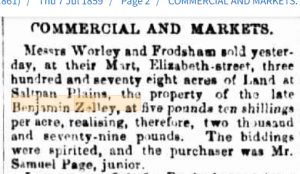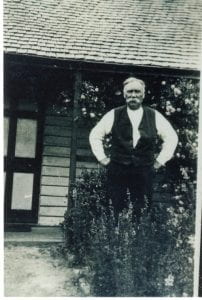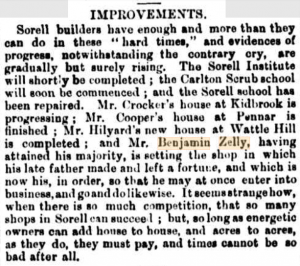Thanks to Helen White for this post as part of the #OnePlaceShows
When an application addressed to the Lieutenant Governor and signed by Mr Edward Lord and others, to hold a public meeting with the intention of forming an Agricultural Society, was published in the Hobart Town Gazette and Van Diemen’s Land Advertiser on Saturday 8 December 1821, the signature of my 3 x great grandfather, Horatio Mason, was affixed to it.
Horatio William Mason arrived in Van Diemen’s Land aboard “Saracen” on 25 April 1820. He was not a farmer, although he had applied for and was granted land at Pittwater; 2000 acres between the Coal River and Orielton Rivulet, he was a trader and soon divest himself of the property.
Another 3-x great grandfather, George Marshall arrived in Hobart Town aboard the brig “Thalia” on 22 April 1822, twelve months after the formation of the Van Diemen’s Land Agricultural Association in 1821 and just days after the meeting on 15 April 1822, which resolved to hold the first Annual Show.
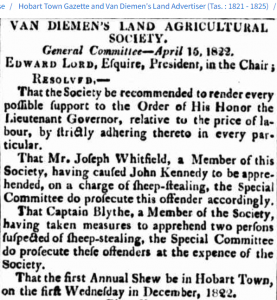
The intention to hold the first Annual Show of the Van Diemen’s Land Agricultural Society might have been the ‘talk of the town’ when he first arrived the week after that meeting. It may have been then that he resolved to participate as an exhibitor at his first opportunity.
Mr. Marshall immediately set about applying for grant of land, but there was some delay in his grant being approved. While awaiting the results of his application he took up a lease on “Noble Farm”, at Pittwater (now Sorell).
The Annual Show to be held on 10 January 1824, gave George Marshall his first opportunity to exhibit and he did so and won the medal for the best boar bred in Van Diemen’s Land. I am unaware if the medal survived in the family, the desire to exhibit certainly did.
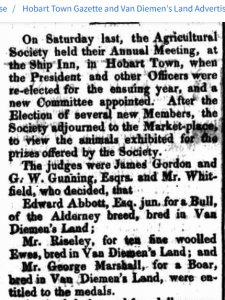
To the best of my knowledge this was his only entry in an Agricultural Show in Hobart Town, but George Marshall was one of the group of farmers in the Richmond/Pittwater District to establish the Richmond Agricultural Society in December 1835, later to become the Southern Tasmanian Agricultural Association. While I have found no record of him exhibiting himself, he remained on the Committee for many years and judged occasionally, but his sons competed regularly entering prime stock and horses in the competitions.
My 2-x great grandfather Thomas Marshall (“Noble Farm”, Sorell) had some success exhibiting draught horses. His brothers, George Marshall Jnr (“Sunnyside”, Sorell) and Edward Marshall (“Cornhill”, Sorell) both exhibited and won prime cattle classes. Thomas’s principal interest was the breeding of draught animals and in order to promote the sires he used and the sale of horses he bred, he travelled to and exhibited at the first Melton Mowbray Agricultural Association Exhibition in December 1864.
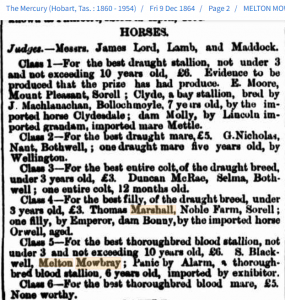
The family involvement with shows has continued to the present day with Life Member Paul Marshall and his family, who stewarded the Commercial Lamb Section of the Royal Hobart Show for many years.
My grandfather, Joel Harvey (he married Kathleen Letitia Marshall) exhibited ‘Fat Lambs’ for many years during the 1930’s and won 3 Jubilee Cups (one for each son). It is quite possible that a relative of mine has been a member of an Agricultural Society in Tasmania since the formation of the Richmond Agricultural Society in 1835, there is certainly been Marshall’s farming in Tasmania since the arrival of George Marshall Snr in 1822.
Readers: Have any of your ancestors been mentioned in results from Agricultural Shows in the district?
